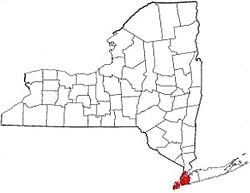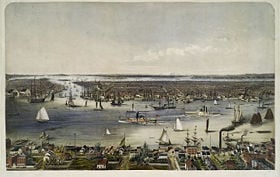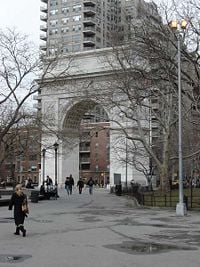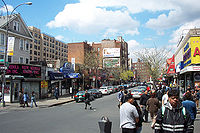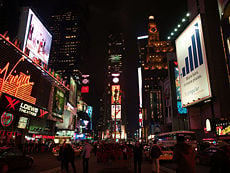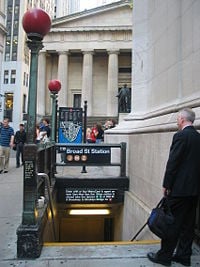New York City
New York City, officially named the City of New York, is the most populous city in the United States, and the most densely populated major city in North America.
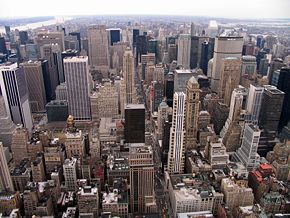
The city is at the center of international finance, politics, entertainment, and culture, and is one of the world's major global cities (along with London, Tokyo and Paris) with a virtually unrivaled collection of museums, galleries, performance venues, media outlets, international corporations, and stock exchanges. The city is also home to the United Nations, along with all of the international missions associated with it.
Located in the state of New York, New York City has a population of 8.1 million within an area of 309 square miles (800 km²). It is at the heart of the New York Metropolitan Area, which is one of the largest urban conglomerations in the world with a population of over 22 million. New York City proper comprises five boroughs: Brooklyn, the Bronx, Manhattan, Queens, and Staten Island, with all but the last having populations exceeding one million.
The city includes large populations of immigrants from over 180 countries who help make it one of the most cosmopolitan places on earth. Many people from all over the United States are also attracted to New York City for its culture, energy, and cosmopolitanism, and by their own hope of making it big in the "Big Apple."
The city serves as an enormous engine for the global economy, with an estimated Gross Metropolitan Product of nearly $500 billion, and is home to more Fortune 500 companies than any other place in the United States. If it were a nation, the city would have the 17th highest gross domestic product in the world, far exceeding that of Switzerland ($377 billion) and nearly equaling that of Russia ($586 billion).
| City of New York, New York | |||
|
|||
| Nickname: The Big Apple | |||
| Location in the state of New York | |||
| Counties (Boroughs) | Bronx (The Bronx) New York (Manhattan) Queens (Queens) Kings (Brooklyn) Richmond (Staten Island) | ||
|---|---|---|---|
| Government | |||
| - Mayor | Michael Bloomberg (R) | ||
| Population (2004) | |||
| - Total | 8,104,079 (city proper) | ||
| 21,923,089 (metropolitan area) | |||
| Time zone | EST (UTC−5) | ||
| - Summer (DST) | EDT (UTC−4) | ||
| Website: City of New York | |||
History of New York City
Long before the arrival of European settlers, the New York City area was inhabited by the Lenape people, including such tribes as the Manahattoes, Canarsies and Raritan; Lenape in canoes met Giovanni da Verrazzano, the first European explorer to enter New York Harbor, in 1524. Following the 1609 voyage of Henry Hudson, European settlement began with the founding of the Dutch fur trading settlement in Lower Manhattan in 1613 later called New Amsterdam (Nieuw Amsterdam) in the southern tip of Manhattan in 1624. Later in 1626, Peter Minuit established a long tradition of shrewd real estate investing when he purchased Manhattan Island and Staten Island from Algonquin tribesmen in exchange for trade goods (legend, now long disproved, has it that the island was purchased for $24 worth of glass beads). Minuit's settlement was also a haven for Huguenots seeking religious freedom.
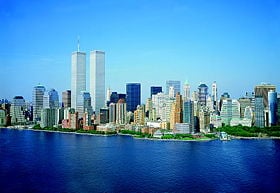
In 1664, English ships captured the city without struggle, and the Dutch formally ceded it to the English in the Treaty of Breda at the conclusion of the Second Anglo-Dutch War in 1667. The city was renamed New York, after James, Duke of York, and became a royal colony in 1685 when James succeeded his brother as King of England.
New York was greatly damaged by fire during the Battle of Brooklyn at the start of the American Revolutionary War, and was occupied by the British until November 25, 1783. On this date, marked annually thereafter as "Evacuation Day", George Washington returned to the city and the last British forces left the United States. The Continental Congress met in New York City under the Articles of Confederation.
On September 13, 1788 the United States Constitutional Convention temporarily set New York City as the first capital of the U.S, and on April 30, 1789 the first President of the United States, George Washington, was inaugurated at Federal Hall on Wall Street. Philadelphia became the next U.S. capital in 1790.
During the 19th century, the city was transformed by immigration, a visionary development proposal called the Commissioners' Plan of 1811, which expanded the city street grid to encompass all of Manhattan, and the opening of the Erie Canal, which connected the Atlantic port to the vast agricultural markets of the Mid-western United States and Canada in 1819. By 1835, New York City had surpassed Philadelphia as the largest city in the United States. Local politics became dominated by Tammany Hall, a Democratic Party political machine. Public-minded members of the old merchant aristocracy pressed for a Central Park, which was opened to a design competition in 1857: it was the first landscape park in an American city.
During the American Civil War (1861–1865), the city's strong commercial ties to the South, its growing immigrant population, and anger about conscription led to divided sympathy for both the Union and Confederacy, culminating in the Draft Riots of 1863, the worst civil unrest in American history. After the Civil War, the rate of immigration from Europe grew steeply, and New York became the first stop for millions seeking a new and better life in the United States, a role acknowledged by the dedication of the Statue of Liberty in 1886.
In two separate actions in 1874 and 1895, New York City (and New York County) annexed sections of southern Westchester County known as the Bronx. In 1898, New York City took the political form in which it exists to this day. Manhattan and the Bronx, though still one county, were established as two separate boroughs and joined together with three other boroughs created from parts of adjacent counties to form the new municipal government originally called "Greater New York". The Borough of Brooklyn incorporated the independent City of Brooklyn, recently joined to Manhattan by the Brooklyn Bridge, and several municipalities in eastern Kings County, New York; the Borough of Queens was created from western Queens County (with the remnant established as Nassau County in 1899); and The Borough of Staten Island contained all of Richmond County. All municipal (county, town and city) governments contained within the boroughs were abolished. In 1914, the New York State Legislature created Bronx county, making five counties coterminous with the five boroughs.
On June 15, 1904 over 1,000 people, mostly German Immigrants, were killed when the steamship General Slocum caught fire and burned on North Brother Island, in the East River; and on March 25, 1911 the Triangle Shirtwaist Factory fire in Greenwich Village took the lives of 145 female garment workers, which would eventually lead to great advancements in the city's fire department, building codes, and workplace regulations.
Throughout the first half of the 20th century, the city became a world center for industry, commerce, and communication. Interborough Rapid Transit (the first New York subway company) began operating in 1904, and the railroads operating out of Grand Central Terminal thrived. New York City became the most populous city in the world in 1925, overtaking London, which had reigned for a century. Despite the effects of the Great Depression, the 1930s saw the building of some of the world's tallest skyscrapers, including numerous Art-Deco masterpieces that are still part of the city's skyline today. Both before and after World War II, vast areas of the city were also reshaped by the rise of the bridges, parks and parkways of coordinator Robert Moses, the greatest proponent of automobile-centered modernist urbanism in America.
A post-World War II economic and residential boom was associated with returning veterans and immigration from Europe, and huge tracts of new housing were constructed in eastern Queens. In 1951, the United Nations relocated from its first headquarters in Flushing Meadows Park, Queens, to the East Side of Manhattan. Like many U.S. cities, New York suffered population decline, an erosion of its industrial base, and race riots in the 1960s, and by the 1970s, the city had gained a reputation for being a crime-ridden relic of history. In 1975, the city government was on the brink of financial collapse and had to restructure its debt through the Municipal Assistance Corporation, headed by Felix Rohatyn. The city was also forced to accept increased scrutiny of its finances by an agency of New York State called the Financial Control Board.
The 1980s saw a rebirth of Wall Street, and the city reclaimed its role at the center of the world-wide financial industry. One of the most notable events in New York City of the 1980's was the record breaking mass wedding of 2075 couples on July 1, 1982 at Madison Square Garden. The wedding was officiated by Rev. Dr. Sun Myung Moon and his wifeDr. Hak Ja Han Moon who are the leaders of the worldwide Unification movement now known as the Family Federation for World Peace.
In the 1990s, crime rates dropped drastically and the outflow of population turned around, as the city once again became the destination not only of immigrants from around the world, but of many U.S. citizens seeking to live a cosmopolitan lifestyle that only New York City can offer. In the late 1990s, the city benefited disproportionately from the success of the financial services industry during the dot com boom, one of the factors in a decade of booming residential and commercial real estate value increases.
New York City was the site of a terrorist attack on September 11, 2001, when nearly 3,000 people were killed by an al-Qaeda terrorist strike on the World Trade Center, including New Yorkers employed in the buildings, passengers and crew on two commercial jetliners, and hundreds of firemen, policemen, and rescue workers who came to the aid of the disaster. Thick, acrid smoke continued to pour out of its ruins for months following the Twin Towers' fiery collapse. The city has since rebounded and the physical cleanup of Ground Zero was completed ahead of schedule. The Freedom Tower, intended to be exactly 1,776 feet tall (a number symbolic of the year the Declaration of Independence was written), is to be built on the site and is slated for construction between 2006 and 2010.
Boroughs and neighborhoods
Residents of the city often refer to the city itself as "the Five Boroughs," reserving the phrase "the City" for Manhattan, and referring to the other boroughs as "the Outer Boroughs", a term that some find pejorative or condescending. However, as more Manhattanites migrate outwards, fleeing sky-high rents, this usage is on the decline. Nonetheless, those less familiar with the city often (incorrectly) think Manhattan is synonymous with New York City. Through the boroughs, there are hundreds of neighborhoods in the city, many with a definable history and character all their own.
- Manhattan (New York County, pop. 1,564,798) is the business center of the city, and the most superlatively urban. It is the most densely populated, and the home of most of the city's skyscrapers.
- The Bronx (Bronx County, pop. 1,363,198) is known as the purported birthplace of hip hop culture, as well as being the home of the New York Yankees. Excluding its minor islands, the Bronx is the only borough of the city that is on the mainland of the United States.
- Brooklyn (Kings County, pop. 2,472,523) is the most populous borough, with a strong native identity. It ranges from a business district downtown to large residential tracts in the central and south-eastern areas.
- Queens (Queens County, pop. 2,225,486) is the most diverse county in the U.S., with more immigrants than anywhere else. Geographically it is the largest of the boroughs, and the legacy of its old constituent towns is still evident. It is also the borough that houses Shea Stadium, home of the New York Mets; two of the three major airports; Flushing Meadows Corona Park home to the 1939 and 1964 World Fairs; and Arthur Ashe Stadium, site of the annual U.S. Open.
- Staten Island (Richmond County, pop. 459,737) is somewhat isolated and the most suburban in character of the five boroughs, but has become gradually more integrated into city life in recent decades, particularly since the opening of the Verrazano Narrows Bridge in 1964.
New York City government
New York City is governed pursuant to the New York City Charter, as amended. The charter is enacted and amended by the New York State legislature, and occasionally through referendum. Though subservient to the State of New York, the city enjoys a high degree of legislative and executive autonomy. Like most governmental entities in the United States, the city government is divided into executive, legislative and judicial branches.
The executive branch of New York City is headed by the Mayor, who is elected by direct popular vote. The Mayor of New York City appoints several Deputy Mayors to head major offices within the executive branch of the city government. Deputy Mayors report directly to the Mayor.
Legislative power in New York City is vested in a unicameral City Council, which contains 51 members, each representing a district of approximately 157,000 people. Council members are elected every four years, and the leader of the majority party is called the Speaker. Like most legislative bodies, the City Council is divided into committees which have oversight of various functions of the city government.
Unlike the rest of New York State, New York City does not have typical county courts. Instead, there is a single Civil Court, with a presence in each borough and city-wide jurisdiction, and a Criminal Court for each New York City county which handles lesser criminal offenses and domestic violence cases, a responsibility shared with the Family Court.
In the rest of New York State, political subdivisions such as cities are contained within counties. Those living outside of cities in New York State automatically live inside towns. Towns, which are county subdivisions in New York State with governments of their own, can also contain villages, which are roughly comparable to what is thought of as a town in most of the United States; that is, villages are small incorporated muncipalities with limited taxation powers. Towns in New York State, on the other hand, are organizationally more like New England townships. In 1898, when New York City was consolidated into its present form, all previous town and county governments within it were abolished in favor of the present five boroughs and unified, centralized city government.
Geography and climate
Geography
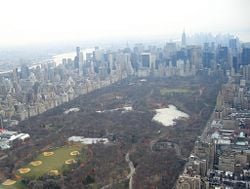
New York City is located in the middle of the BosWash megalopolis, 218 mi (350 km) driving distance from Boston and 232 miles (373 km) from Washington, D.C. The city is situated on the three major islands of Manhattan, Staten Island, and on western Long Island (Brooklyn and Queens), as well as on the mainland in the Bronx. There are also some smaller islands in the surrounding waters, including Ellis Island, Governors Island, Liberty Island, Roosevelt Island, and small islands located in Jamaica Bay.
The Hudson River flows from the Hudson Valley into New York Bay, becoming a tidal estuary that separates the Bronx and Manhattan from New Jersey. The East River, really a tidal strait, stretches from the Long Island Sound to New York Bay, separating the Bronx and Manhattan from Long Island. The Harlem River, another tidal strait between the East and Hudson Rivers, separates Manhattan from the Bronx.
Upper New York Bay is surrounded by Manhattan, Brooklyn, Staten Island, and the coast of New Jersey, and is connected by the Narrows between Brooklyn and Staten Island to Lower New York Bay, which is partially surrounded by Brooklyn, Staten Island, and the coast of New Jersey, and opens to the Atlantic Ocean.
Climate
New York has a humid continental climate, though being adjacent to water it suffers less temperature fluctuation than inland areas. New York winters are typically cold (though not severely so; temperatures below 0 °F (-18 °C) only occur about once per decade on average) temperatures in the 10's and 20's are quite common at the height of winter, and New York winters sometimes feature snowstorms that can paralyze the city with over a foot (30 cm) of snow (such as the Blizzard of 1888, which led to the city's telephone and telegraph lines moving underground and led to the building of the subway). Thunderstorms are common in spring and summer, although severe weather is more common west of the city in New Jersey because the city's proximity to the ocean usually kills severe thunderstorms before they hit the city. Hurricanes are considered to be a major threat to the area (and especially the Long Island suburbs); a direct hit could cause large loss of life and billions of dollars in damage due to the high population in coastal areas. Summers in New York are hot and humid, with temperatures commonly exceeding 90 °F (32 °C), although high temperatures above 100 °F (38 °C) are about as rare as subzero (F) lows in winter, humidity levels are usually quite high in July and August. Autumns are comfortable in New York and similar to spring in temperature. Travelers are advised to check forecasts and bring several layers of clothing in late fall and in the early spring months (e.g., November, March, April) as temperatures are flucuate quickly at these times of year.
According to the United States Census Bureau, the city has a total area of 1,214.4 km² (468.9 mi²). 785.6 km² (303.3 mi²) of it is land and 428.8 km² (165.6 mi²) of it is water. The total area is 35.31% water.
Demographics
As of the censusGR2 of 2000, there are 8,008,278 people, 3,021,588 households, and 1,852,233 families residing in the city. The population density is 10,194.2/km² (26,402.9/mi²). There are 3,200,912 housing units at an average density of 4,074.6/km² (10,553.2/mi²). The racial makeup of the city is 44.66% White, 26.59% Black or African American, 0.52% Native American, 9.83% Asian, 0.07% Pacific Islander, 13.42% from other races, and 4.92% from two or more races. 26.98% of the population are Hispanic or Latino of any race. 35.9% of the population was born outside the United States of America (18.9% born in Latin America, 8.6% Asia, 7.0% Europe). The ethnic makeup is 11.5% African-American, 9.8% Puerto Rican, 8.7% Italian, 5.3% Irish, 5.1% Dominican, 4.5% Chinese, and 1.7% Filipino.
New York City is also home to the nation's largest community of American Jews, with an estimate of 972,000 in 2002, and is the worldwide headquarters of the HasidicLubavitch sect and the Bobover and Satmar branches of Hasidism. Per capita income is $22,402; men and women have a median income of $37,435 and $32,949 respectively. 21.2% of the population and 18.5% of families are below the poverty line, of whom 30.0% are under the age of 18 and 17.8% are 65 and older. According to the U.S. Census, New York City has the largest estimated daytime population, at more than 8.5 million persons. The increase of more than half a million people over the nighttime population is bigger than that found in any other area. However, the 7 percent increase puts New York in the middle of the pack on percentage change among cities with more than a million residents.Crime
Since 1991, New York City has seen a continuous trend of decreasing crime and has become the safest large city in the United States. Neighborhoods that were once considered dangerous now thrive with new businesses and housing, and many residents feel safe to walk the streets late at night. The murder rate in 2004 was at its lowest level in over forty years: there were 572 murders that year, for a murder rate of 7 per 100,000 people, compared to 2,245 murders in 1990.
New Yorkers are famous for doing things "bigger and better," and this sometimes has applied to criminal activity in the City: Organized crime has been associated with New York City since the early 20th Century, when legendary mobsters roamed and controlled certain areas of the city and many businesses. In the 1980's prosecutors like Rudolph Giuliani became famous for successfully prosecuting notorius crime bosses which gave alot of hope to people all over the USA that organized crime was not invincible and that the justice that was due for Mafia groups could be accomplished.
For New York City crime Statistics see the NYPD's Precinct Crime Statistics page.
Economy
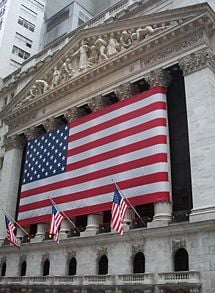
Historically, the city developed because of New York Harbor, widely considered one of the finest natural ports in the world. The value of this port was greatly expanded upon in 1819 with the opening of the Erie Canal, which gave New York an enormous advantage over the competing ports of Boston and Philadelphia. The old port facility was at the South Street Seaport in Manhattan, but today there is still residual activity remaining at Red Hook in Brooklyn, and the Howland Hook Marine Terminal in Staten Island. Red Hook, for instance, handles the majority of the cacao bean imports to the United States. Since the 1950s, most shipping activity in the area has shifted to Port Newark-Elizabeth Marine Terminal in New Jersey. But despite changes in international shipping, trade and the tertiary sector have always remained the real basis of New York's economy.
Manufacturing first became a major economic base for New York City in the mid-nineteenth century with the advent of industrialization and the railroad. New York was formerly a national center for clothing manufacture, and some continues, sometimes in sweatshops. There are still around 120,000 manufacturing jobs in the city compared to over a million in the middle of the 20th century. Like international shipping, though, manufacturing gradually declined in the late-twentieth century with rising land values. The city was also a first center of the American film industry, along with Chicago, Illinois, until it moved to Hollywood, California, and still has some television and movie production.
Today, New York City is the chief center of finance in the world economy, with Wall Street in Lower Manhattan's Financial District. Financial markets based in the city include the New York Stock Exchange, NASDAQ, American Stock Exchange, New York Mercantile Exchange, and New York Board of Trade. Many corporations also have their headquarters in New York.
New York is also the center of many of the service sector industries in the U.S., with more Fortune 500 companies headquartered in the city than anywhere else in the country. The city is by far the most important center for American mass media, journalism and publishing. Manhattan's Madison Avenue is synonymous with the American advertising industry, while Seventh Avenue is nicknamed "fashion avenue" as it serves as an important center for the fashion industry. Ninety percent of the diamonds imported to the United States pass through New York, and most of these are handled and cut in the city's Diamond District on 47th Street between Fifth and Sixth Avenues. New York also has among the most important scenes for art, music, and theater in the U.S., with an increasingly active artists' community. Being that New York City is a teeming, diverse world city, it is one of the most popular destinations for tourism and business in the USA.
Culture of New Yorkers
New York City, sometimes called "The City That Never Sleeps," is famously fast-paced and active, and the American idiom "in a New York minute" means "immediately." New York City residents are called "New Yorkers". Residents of the metropolitan area generally refer to New York City (or sometimes just Manhattan) as "The City," or "New York," and the acronym "NYC", as opposed to just "NY", helps to avoid confusing references to the State of New York. The nickname most used for New York City is the "Big Apple".
Immigration and international flavor
New York absorbs a greater diversity of immigrant groups than any other American city, and it absorbs a larger number of immigrants every day than all other U.S. city except Los Angeles, giving New York an international flavor, and making it the archetype of the American ideal of a melting pot – a nation of immigrants. The city government employs translators in 180 languages.
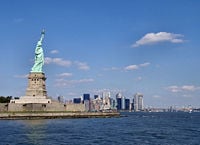
Some celebrated ethnic/racial neighborhoods include Harlem, Little Italy, Flushing, Jackson Heights, Chinatown, Washington Heights, Briarwood, and the Lower East Side.
The Lower East Side and The East Village are where the term "The Melting Pot" came to be, referring to the droves of people from diverse European nations squeezing into this small, 100 block or so area of tenements, learning to live together for the first time.
Commuter culture
Because of traffic congestion and the well-designed New York Subway, six in ten residents, including many middle class professionals, commute to work via public transportation, making the everyday lifestyle and "pedestrian culture" of New Yorkers substantially different from the "car culture" that dominates most American cities. This pattern is strongest in Manhattan, where subway service is better and traffic is worse than in the outer boroughs. Even the city's billionaire mayor, Michael Bloomberg, is a "straphanger" (subway commuter), and can be encountered on the train to City Hall each morning. Outside of the city, hundreds of thousands of workers commute daily from throughout the Tri-State Region of New York, New Jersey, and Connecticut by commuter rail service, particularly Metro-North, LIRR, New Jersey Transit, and PATH. A less favored alternative to commuting via rail is the region's outdated and congested highway network.
Tourism and recreation
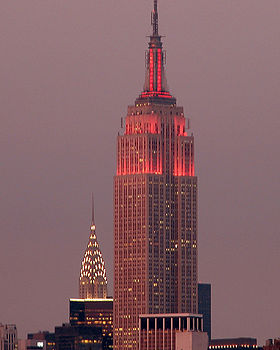
Tourism is a major local industry, with hundreds of attractions and 39 million tourists visiting the city each year on average. Many visitors make it a point to visit the Empire State Building, Times Square, Radio City Music Hall, the Statue of Liberty, Ellis Island, Wall Street, United Nations Headquarters, the American Museum of Natural History, St. Patrick's Cathedral and the Brooklyn Bridge, among other attractions.
There are over 28,000 acres (113 km²) of parkland found throughout New York City, comprising over 1,700 separate parks and playgrounds. The best known of these is Central Park, which is one of the finest examples of landscape architecture in the world, as well as a major source of recreation for New Yorkers and tourists alike. Other major parks in the city include Riverside Park, Battery Park, Bryant Park, Prospect Park, Flushing Meadow-Corona Park, Washington Square Park, and Forest Park. The city also has 578 miles (930 km) of waterfront and over 14 miles (22 km) of public beaches.
The first Macy's Thanksgiving Day Parade was held in New York on November 27, 1924. Since then this has been an annual event drawing tens of thousands of spectators and in later years millions of television viewers. Annually on New Year's Eve, hundreds of thousands of people congregate in Times Square to watch the ball drop as millions watch on television.
The World Trade Center was an important tourist destination before the September 11, 2001 attacks, which devastated the city and its tourist industry. The city was nearly devoid of tourists for months, and it took two years for the numbers to fully rebound with fewer international, but more domestic visitors. Now the World Trade Center site has itself become an important place for visitors to see.
Cultural institutions
New York is a city of great museums with the Metropolitan Museum of Art's assemblage of historic art, the Museum of Modern Art and Guggenheim Museum's 20th century collection, and the American Museum of Natural History and its Hayden Planetarium focusing on the sciences. There are also many smaller specialty museums, from El Museo del Barrio with a focus on Latin American cultures to the Cooper-Hewitt National Museum of Design. A number of the city's museums are located along the Museum Mile section of Fifth Avenue.
In addition to these museums, the city is also home to a vast array of spaces for opera, symphony, and dance performances. The largest of these is Lincoln Center for the Performing Arts, which is actually a complex of buildings housing 12 separate companies, including the New York Philharmonic, the Metropolitan Opera, the New York City Opera, the New York City Ballet, and Jazz at Lincoln Center. Other notable performance halls include Carnegie Hall, Radio City Music Hall, and the Brooklyn Academy of Music.
Media and entertainment
Because of its sheer size and cultural influence, New York City has been the subject of many different, and often contradictory, portrayals in mass media. New York has served as the unwitting backdrop for virtually every conceivable viewpoint on big city life. New York’s portrayal on television is similarly varied, with a disproportionate number of crime dramas taking place in the city despite the fact that it is one of the safest cities in which to live in the United States. New York has also been the setting for countless works of literature, many of them produced by the city’s famously large population of writers (including Jonathan Franzen, Don Delillo, Jonathan Safran Foer, Thomas Pynchon, Susan Sontag, and many others).
New York City boasts over forty daily newspapers in several different languages, including such national heavyweights as The Wall Street Journal (daily circulation of 2.1 million) and The New York Times (1.6 million), and America's oldest continuously-published newspaper, The New York Post, founded in 1801 by Alexander Hamilton.
New York City also has studios, and is the home and broadcasting capital for the four major U.S. television networks, ABC, CBS the Fox Network, and NBC, as well as news organization CNN, and while the local film industry is dwarfed by that of Hollywood, its billions of dollars in revenue make it the second largest in the nation.
With its connection to media and communications and its mix of cultures and immigrants, New York City has had a long history of association with American music. The city has served as an important center for many different genres of music ranging from Big Band Era and jazz, from Punk Rock to Goth and Hip-hop (the latter of which is generally acknowledged as having originated in the Bronx around 1973).
The East Village and Lower East Side continue to shine as the city's premier destination for music (rock, blues, jazz, dance), art (mixed media) and indie theater (experimental, off-broadway.) From CBGB's to LaMama Theater to the Amato Opera House, this area is famous for having a "venue on every block."
Theater
New York City boasts a highly active and influential theater district, which is centered around Times Square in Manhattan. It serves both as the center of the American theater industry, and as a major attraction for visitors from around the world. Along with those of London’s West End theater district, Broadway theaters are considered to be of the highest quality in the world. Despite the name, many "Broadway" theaters do not lie on Broadway the street, and the distinction with Off-Broadway and Off-Off-Broadway (which tend more toward experimental theater) is simply a reference to the seating capacity of the theater.
Professional sports

Although in much of the rest of the country American football has become the most popular professional sport, in New York City baseball arguably still stirs the most passion and interest. A "Subway Series" between city teams is a time of great excitement, and any World Series championship by either the New York Yankees or the New York Mets is considered to be worthy of the highest celebration, including a ticker-tape parade for the victorious team. For most American baseball fans, the most intense rivalry is between the Yankees and the Boston Red Sox, but in the city the rivalry between the Yankees and the Mets is just as fierce. Outsiders are frequently unaware that few baseball fans in New York are fans of both teams at once.
The New York metropolitan area is the only one in the United States with more than one team in each of the four major sports, with nine such franchises.
New York City was the host of the 1998 Goodwill Games
Transportation
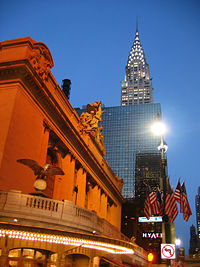
Unlike most of America's car-oriented urban areas, public transportation is the common mode of travel for the majority of New York City residents. As of 2001, 50% of New York City households and only 20% of Manhattan households had access to a vehicle, as compared to more than 90% nationwide. The city is served by an extensive network of parkways and expressways.
Mass transit
New York City boasts the most extensive network of public transportation in the United States. The world-famous New York City Subway is operated by the Metropolitan Transportation Authority (MTA). It is the most extensive subway system in the world when measured by mileage of track (656 miles of mainline track), and the fifth largest when measured by annual ridership (1.4 billion passenger trips in 2004). The subway system connects all boroughs except Staten Island, which is served by the Staten Island Railway via the free Staten Island Ferry (which connects to the 1 subway line). The city is also served by the Port Authority of New York and New Jersey's PATH subway system, which connects the borough of Manhattan to New Jersey. In addition to these, city residents rely on hundreds of bus lines, both publicly and privately operated (many to be taken over by the MTA sometime in 2005), which serve nearly all areas of the five boroughs.
Airports
The Port Authority also owns and operates the four major airports in the New York City area, John F. Kennedy International Airport (JFK) in Jamaica, Newark Liberty International Airport in Newark, New Jersey, La Guardia Airport in Flushing, and Teterboro Airport in Teterboro, New Jersey. JFK tends to handle international traffic, whereas La Guardia tends to handle shorter domestic flights, and Newark handles both international and domestic; Teterboro is New York's primary general aviation airport, handling heavy business jet traffic together with cargo and medevac flights and some light plane traffic.
Ferries
Many private ferries are run by NY Waterway, which provides several lines across the Hudson River, New York Water Taxi, with lines connecting Brooklyn and Manhattan, and other operators. There is also the free Staten Island Ferry between Manhattan and Staten Island, operated by the New York City Department of Transportation.
Education and scientific research
Colleges and universities
New York City is served by the publicly-run City University of New York (CUNY), the largest urban university in the United States, which has a number of campuses throughout the five boroughs. The city is also home to a number of other institutions of higher learning, some of national or even international reputation, including Columbia University, Fordham University, Manhattan College, New York University, the Juilliard School, The Cooper Union, Marymount Manhattan College and The New School.
New York City is also a major center of academic medicine. Manhattan contains the campuses of the world-class Rockefeller University, Weill Cornell Medical College, and Memorial Sloan-Kettering Cancer Center, as well as Columbia-Presbyterian Medical Center and NYU Medical Center and their medical schools. In the Bronx, the Albert Einstein College of Medicine of Yeshiva University is a major academic center. Jonas Salk, developer of the vaccine for polio, was an intern at Mount Sinai Medical Center in Upper Manhattan. Brooklyn also hosts one of the country's leading urban medical centers: SUNY Downstate Medical Center, an academic medical center, the oldest hospital-based medical school in the United States. Professor Raymond Vahan Damadian, the inventor of the MRI, was part of the faculty from 1967 - 1977 and built the first MRI machine, the Indomnitable, there.
New York City is home to several of the nation's top schools of art and design, including Pratt Institute, the School of Visual Arts, the Fashion Institute of Technology, and Parsons School of Design.
Skyline
New York City has the most famous skyline in the world; because of both its high residential density, and the extremely high real estate values found in the city's central business districts, New York has amassed the largest collection of office and residential towers in the world. In fact, New York actually has three separately recognizable skylines: Midtown Manhattan, Downtown Manhattan (also known as Lower Manhattan), and Downtown Brooklyn.
New York City has a long history of tall buildings. It has been home to 10 buildings that have held the world's tallest fully inhabitable building title at some point in history, although half have since been demolished. The first building to bring the world's tallest title to New York was the New York World Building, in 1890. Later, New York City was home to the world's tallest building for 75 continuous years, starting with the Park Row Building in 1899 and ending with 1 World Trade Center upon completion of the Sears Tower in 1974. One of the world's earliest skyscrapers, still standing in the city, is the Park Row Building, built in 1899.
Trivia
- With over 8 million residents, New York City has a larger population than 39 U.S. states. It has more than twice the population of Los Angeles, the second largest city in the country, and more than 27 times the population of Buffalo, the second largest city in the state of New York.
- If each borough — Brooklyn, Queens, Manhattan, the Bronx, and Staten Island — were to become an independent city, they would rank as the 3rd, 4th, 6th, 9th, and 42nd largest cities in the U.S., respectively.
- Approximately two out of five New York State residents live in New York City.
External links
- NYC.gov – official website for the city
- NYC Bloggers – thousands of New York blogs organized by subway stop
- Times Square Webcams
- New York City Wiki – current events
Credits
New World Encyclopedia writers and editors rewrote and completed the Wikipedia article in accordance with New World Encyclopedia standards. This article abides by terms of the Creative Commons CC-by-sa 3.0 License (CC-by-sa), which may be used and disseminated with proper attribution. Credit is due under the terms of this license that can reference both the New World Encyclopedia contributors and the selfless volunteer contributors of the Wikimedia Foundation. To cite this article click here for a list of acceptable citing formats.The history of earlier contributions by wikipedians is accessible to researchers here:
The history of this article since it was imported to New World Encyclopedia:
Note: Some restrictions may apply to use of individual images which are separately licensed.

